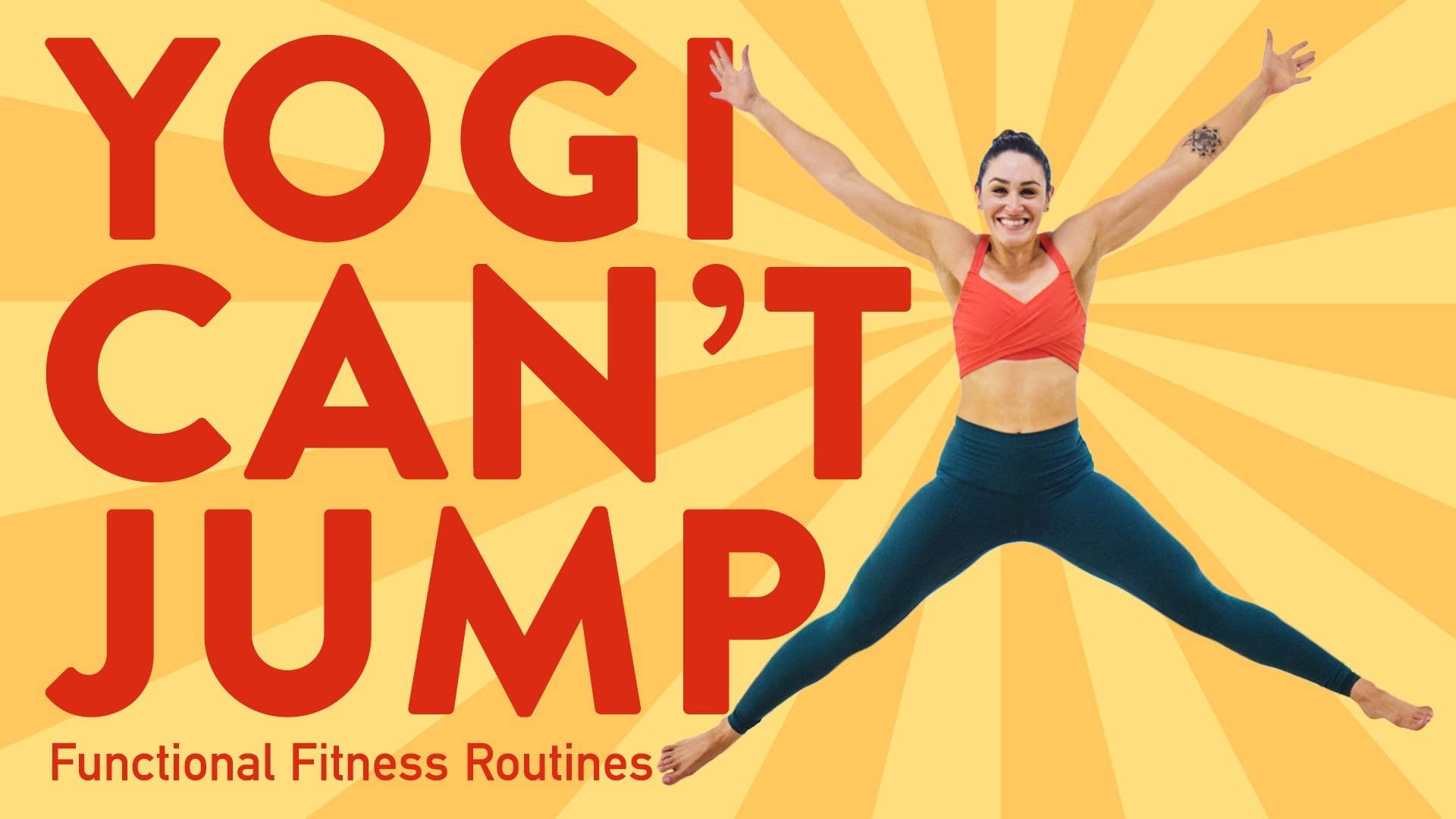Description
About This Video
Transcript
Read Full Transcript
Hey guys, welcome. We are here to learn all about the squat and all the different forms that we use in all of our other videos. So let's start from the ground up. Your connection, the connection from your feet to the ground is really important. You want to keep your toes and your heels on the mat at all times.
So try it with me. Stand on your mat, push your toes down, and maybe even squeeze your quads a little bit just to get that feel of the ground. I think we have a pretty strong feeling without shoes on, which is why I like to do a lot of my practice without shoes. You can obviously wear shoes, especially if you're afraid of impact, but for now, take your shoes off and just try it with me without. So toes stable, heels on the ground, and make sure that, let's move up a little bit.
Now we're talking about your shins. Your shins are going to stay where they are, but your hips are going to move back. So we went toes, shins, hips. So from the side, I just want you to stand there, put your hands right here on your pelvic bone, and push your hips back. I don't want you to move your shins at all.
So shins are here, by the way, if you had any confusion. Here, push back. This is the hinging motion that a lot of us lose from being on the computer all day long. Core engagement, glute engagement, thighs, it's true when you don't use it, you lose it. It's true.
So let's bring it back, and the hardest part of the squat, a lot of times, is this hinging motion. When you hinge back, your weight is going behind you, just like you would be sitting down on a chair. So a lot of times, how we start is having a chair behind you, standing in front of it, and pushing your hips back, sitting down and standing up. Now, we don't have the chair, totally okay. So I want you to stand straight up, chest up, put your hands on your hips, and keep pushing your hips back and standing up.
If it helps, use a mirror, stand next to a mirror so you can see that it's almost like a drawer. Somebody is pulling your hips back behind you, and you're standing up. Legs are bending naturally, it's not super exaggerated, it's not stiff. We're just working on this hinging motion. Okay, let's do that five times.
One, two, three, four, and five. Now I'm going to bring attention to other things, so that's the basic move. Now, your quads and your glutes are also activated in this motion. So I want you to try the hinging motion again. Put your hands on your hips, push back, and when you stand up, squeeze your glutes, squeeze your quads.
Let's do that five times. Sit back, stand up, squeeze. Again, two, stand up, squeeze. And I mean squeeze, not like squeeze, three, four, and five. Good.
You should feel a difference already. It doesn't matter how low you go, I'm just focusing on this hip hinging motion. You should naturally feel your weight transferring from your toes to your heels as you move back and forth. It doesn't mean that your toes are coming up. In fact, if you put almost the same amount of weight, because it's obviously we're shifting the weight back, but if you keep your toes planted, your glutes activate more.
We used to say, let your toes come up, but right now I just want you to keep your stability by keeping your feet on the ground, pushing your hips back. Now let's get a little lower. So when you sit all the way back and stand up, maybe relax your arms, take a deep breath in, sit back, squeeze, and exhale. Now we're on our core. So when you exhale, it's an actual contraction of your abdomen.
I'm doing it as I speak. It's hard to speak because you're contracting your abs. It's not sucking in. It's not, most, I feel like people go, that's their ab engagement. It's actually just standing up straight and just contracting your abdomen.
So if you exhale really hard, that's the ab engagement. So try the ab engagement with me for a second. Take a deep breath in. You should feel your core contracting. Now if we put it together, if you sit back, stand up, squeeze, rock solid when you're standing up.
It's not shaky. You want it to be pretty because when it's pretty, you're doing it right. Think about it that way. If you stand in front of a mirror and you sit back and you stand up and you're rock solid, it looks a lot nicer than, right? Okay.
So now we're here. Let's talk about our shoulders. Sometimes because of work on the computer, because of the fact that we don't necessarily know or are aware of what our muscles should be doing when you're standing up straight, I personally have a lot of trouble with posture or I did when I first started exercise. A big part of a squat is making sure your shoulders are pulled back and down. Put your hands right underneath your armpits right here.
This is your lats. They're going to come up a lot. These guys help pull your shoulders down. When you're doing pull ups, they help pull you up. They're very important in everything that you do, but you have to know where they are.
So a lot of times I'll have everyone touch right here so that you actually know where they are. So when you sit back, you stand up, you pull your shoulders back, but it's more than that. I can feel my armpits. If you know where they are, you can pull your shoulders back and that's lat engagement. So that naturally brings your chest up.
Proud chest, flat back, and there's no bending over. If you have the hip hinge, then you're just letting that drawer pull back and your shoulders stay up and then you squat down. Stand up, exhale. Something else is helpful is if you put your hands up and pretend like you're holding a big beach ball, but your pinkies are engaged. Pinkies are connected to your lats, so let's put our hands up and do five squats.
Sit back with the hip hinge, stand up and squeeze. Back, that's two, three, four, one more, five, good. Some things to keep in mind. Your feet, the distance between your feet is actually all about your anatomy. Try not to go too wide, try not to go too narrow.
There's a space between your shoulder, your armpits, your shoulders, and a little bit wider than your hips. That's normally the most natural form of a squat for people. So don't try to push it too much. They doesn't need to be extremely wide. And something else to keep in mind is knees never go over your toes.
This is never going to be a squat. But if you have that hip hinge and the shins don't move, you avoid it. So let's learn the right way rather than trying to correct yourself all the time, okay? Your gaze is also very important. Don't look down, don't look up, look straight ahead.
Keep it simple, right in this little abyss. If you want to step back away from your mat, it's usually like a foot or two off the mat. That should be perfect. So in our videos, we work with a number of different variations of the squat. It's all the basic thing.
There is squat reaches, which is a really good alternative if you're really not ready to jump. It uses the heart rate a little bit more, it gets you going a little bit more, and how you do that is you use your basic squat, you use your arms to pull yourself back, and you reach up, you're going up on your tippy toes, your calves are engaged, your glutes are engaged, your quads are engaged, and you're exhaling, which engages your abs. But it's a little bit faster, so you give your heart rate up a little. A step up from that would be a squat jump. So same dynamic, sitting down with your hands up, and you're going to push yourself off the ground.
So again, you're hinging back, your weight's in your heels, but your toes are still on the ground, and you lift yourself up. It doesn't have to be a huge jump. It can be a tiny jump, but the consistency and the speed is what gets you to really sweat or to not expel that much energy. There are variations like where we move side to side, or when we shift our weight side to side, so lateral movement, and one of them is squat, step, squat, back, squat, right? Same movement, we're just moving side to side.
The biggest thing to remember in that particular exercise is to keep your weight center. Just because you're stepping to the side doesn't mean that your weight transfers to the side. You're stepping to the side and you're centering yourself and then going down, okay? Wide squats also come up, or sumo squats, a lot of times is what they're referred to. That's when your legs are wider than your hips, but you're still sitting back and standing up.
Nothing too complicated about those. Your toes are pointing out a little bit more as well. The fourth kind, which is what we use in the level three videos, is a tuck jump, or a really big jump if you don't want to do a tuck jump. So either you're jumping as high as you can, or you bring your feet in to your chest and it looks a little like this. The biggest thing to remember is the landing has to be really soft.
So you're going toes, the pads of your feet, and then the rest of your feet come down. So if you can't do it silently, you're not doing it soft, and I want you to back off. Your knees are important, your joints are important, and you have to make sure that you have the proper form before you really expel all of that energy. So if we were to practice, jump up. You almost land with bent knees so that you're landing softly.
I always say, don't wake the baby, right? If you're doing this at home, you really don't want to wake the baby. So jump softly, and there is a way to control it, and you'll get there. All right, so that's all we have for the squat tutorial. I hope you've enjoyed it.
Come back for more.
Yogi Can't Jump
Comments
You need to be a subscriber to post a comment.
Please Log In or Create an Account to start your free trial.















